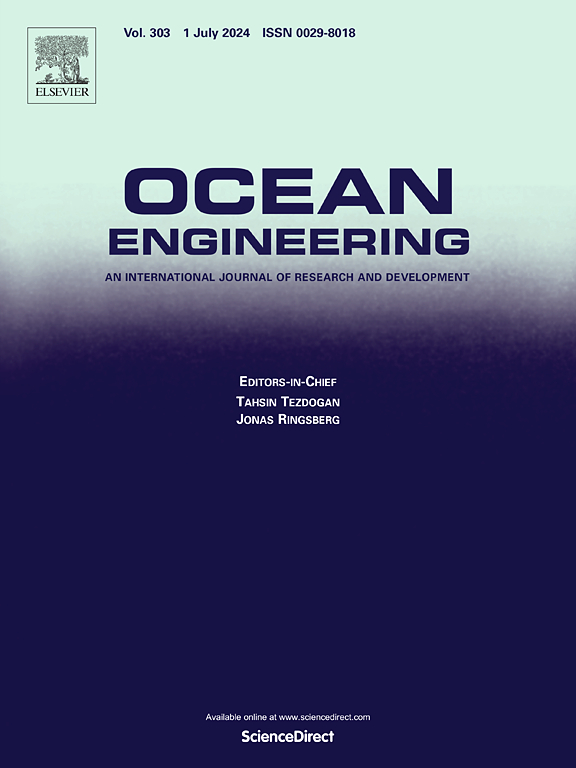Numerical simulation and experimental study of hydrodynamic performance on a maneuvering SUBOFF
IF 4.6
2区 工程技术
Q1 ENGINEERING, CIVIL
引用次数: 0
Abstract
This study focuses on the maneuverability of underwater vehicles by establishing a numerical towing tank and a numerical rotating arm basin for hydrodynamic analysis of maneuvering motions. Using CFD and overset grid techniques, the primary hydrodynamic coefficients of the standard SUBOFF model were obtained. Additionally, the flow characteristics around the model during oblique motion and turning maneuvers, as well as the effects of viscosity on the surrounding flow field, were analyzed. Maneuverability experiments for the SUBOFF model were carried out in a rotating arm basin, investigating the force characteristics in both single-plane and spatial turning motions. The linear and nonlinear viscous hydrodynamic coefficients during horizontal plane rotation, ascent, and descent in the vertical plane were determined, and the effects of turning radius, drift angle, and angle of attack on the primary hydrodynamic forces were examined. The rotational derivatives and experimental data obtained were compared with international experimental results, validating the feasibility and accuracy of the numerical simulations from both theoretical and experimental perspectives. The maneuverability experiments contribute to the advancement of rotating arm test techniques for underwater vehicles, while the experimental data help to fill gaps in the hydrodynamic coefficient database of the SUBOFF model, particularly regarding angular velocity-dependent coefficients.
机动潜水器水动力性能的数值模拟与实验研究
本研究通过建立数值拖曳槽和数值旋臂池对水下航行器的机动运动进行水动力分析,重点研究水下航行器的机动性能。利用CFD和重叠网格技术,得到了标准SUBOFF模型的主要水动力系数。此外,还分析了模型在倾斜运动和转弯机动时的流动特性以及黏度对周围流场的影响。在旋转臂盆中进行了SUBOFF模型的机动性实验,研究了单平面和空间旋转运动下的力特性。确定了水平面旋转、垂直平面上升和下降时的线性和非线性粘性水动力系数,考察了转弯半径、漂移角和攻角对主水动力的影响。将得到的旋转导数和实验数据与国际上的实验结果进行了比较,从理论和实验两方面验证了数值模拟的可行性和准确性。机动性实验有助于水下航行器旋转臂测试技术的进步,而实验数据有助于填补水下航行器模型水动力系数数据库的空白,特别是在角速度相关系数方面。
本文章由计算机程序翻译,如有差异,请以英文原文为准。
求助全文
约1分钟内获得全文
求助全文
来源期刊

Ocean Engineering
工程技术-工程:大洋
CiteScore
7.30
自引率
34.00%
发文量
2379
审稿时长
8.1 months
期刊介绍:
Ocean Engineering provides a medium for the publication of original research and development work in the field of ocean engineering. Ocean Engineering seeks papers in the following topics.
 求助内容:
求助内容: 应助结果提醒方式:
应助结果提醒方式:


